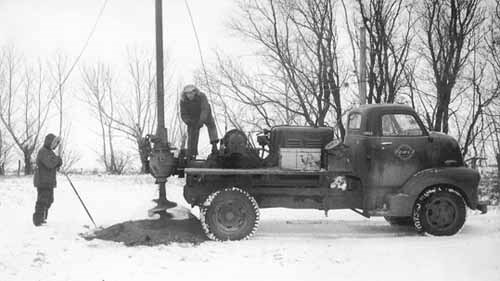As part of the Heritage Day 2012 program at the Western Development Museum branch in Yorkton Sunday Carla Madsen, education and special events coordinator with the local WDM gave a presentation on rural electrification in Saskatchewan during the 1950s.
"Before the arrival of electricity, life on Saskatchewan farms offered little in the way of convenience, comfort or leisure time," she said.
"With the inauguration of the Rural Electrification Program by the Saskatchewan Power Corporation in 1949, all this changed.
"With the flick of a switch, the central yard light lit up the farmstead.
"Electric lights shone in the farm house and the barn.
"Radio, and later television, brought the outside world in.
"Electric washers lifted the burden of hours of washday work on "Blue Monday".
"Perishable foods could now be kept fresh in electric refrigerators, with months of additional supplies kept secure in the deep freezer."
Interestingly Saskatchewan was slow to turn to electricity.
"While the province of Saskatchewan is often cited for its "firsts", it was last when it came to rural electrification," said Madsen, citing the large area to cover with transmission lines, and the lingering effect of the 'Dirty Thirties' on the economy as reasons for the delay.
The move to electrifying the province really began with the passage of "The Rural Electrification Act in 1949 by the Government of Saskatchewan, converting the Saskatchewan Power Commission into a Crown corporation, the Saskatchewan Power Corporation."
In 1949 a modest goal was set of connecting 1,200 rural customers. It was considered a "test year" as costs would be tremendous, there was a late start and also a shortage of materials after the war.
"The CCF`s 1952 election promise was to increase electrical service from 4,000 to 40,000 farms in four years. This meant that 28,000 farms (an average of 7,000 farms per year) would have to be hooked up, which was double the number in the 1951 program," said Madsen.
1956 was the peak year for rural electrification in Saskatchewan and by the end of the year, the CCF`s 1952 election promise had been achieved with 40,000 farms (about 47 per cent) being served by high line power. In addition, hundreds of non-farm customers in rural areas were given service, including schools, churches and community halls
The electrification of rural Saskatchewan was not something farmers were clamouring for.
Quoting the 1944 report of Saskatchewan Reconstruction Council, Madsen said, "It must be demonstrated to the farmer that he can benefit from electricity before he will use it."
Madsen said farmers would require convincing.
"The early 1950s saw a strong start to the Rural Electrification Program, however, many farmers - especially straight grain farmers - saw electrical appliances and equipment as unnecessary. Many could not see the benefit that may be gained given the costs of wiring buildings and purchasing household and farm equipment. The Saskatchewan Power Corporation soon realized that it would have to promote the farm electrification program to enable farmers to appreciate the value of electricity," she said.
In most cases the home was the primary user of electricity on the farm, and Madsen said considerable promotion went into ensuring women saw the benefits to having power.
"There is no place where electricity can do more to lighten labour than in the farm kitchen, the workshop of the home," said Madsen quoting from 'Electricity on the Farm' circa 1950.
"It has been estimated that the number of steps taken by a woman in doing the household farm work equals and sometimes exceeds that of the man on the farm it must be remembered that farm work is often done by power equipment - tractors, trucks and cars. There are no tractors in the farm house."
"After electric lighting, the most useful improvement and greatest labour saver is a supply of running water the job of keeping a water supply available in the farm home largely falls to the farm wife. An electric pump can do all this work for her."
Electricity was also cited as easing the workload associated with the disliked job of washing clothes.
"Probably the most disliked task of all housework is washing the family clothes. This is especially true on farms because there are more heavy clothes and they are more soiled than in the city home. Home laundry equipment, electrically operated, is undoubtedly what every farm woman needs with an electric washer equipped with the new type wringer, the backache is taken out of Blue Monday," said Madsen, citing oneyellowcottage.blogspot.com.
Madsen said while initially resistant to the idea of rural electrification, ultimately it was a major step forward.
"In 1956, the Royal Commission on Agriculture and Rural Life found that farm families were not content with the disparity between the material levels and commercial services between rural and urban life. It also found "a deep anxiety in farm people" about the permanent movement of young people away from Saskatchewan farms. It was hoped that electricity on the farm would slow the movement of young farm people to the city by bringing the farm most advantages and comforts that were enjoyed by urban residents," she said.




